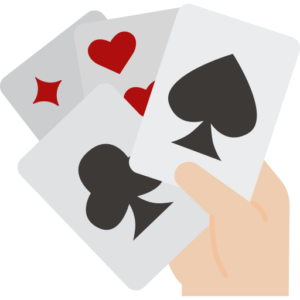Glossary Term
Outs


Outs
Used In: Poker
Introduction
In poker, the concept of outs is central to understanding how likely a player is to improve their current hand as the game progresses. Outs are the specific unseen cards remaining in the deck that will enhance a player’s hand to a potentially winning combination. By identifying these cards, players can assess the chances of completing draws such as flushes, straights, or sets, which directly impacts their decision-making process during betting rounds.
Calculating outs is a fundamental skill in poker strategy because it allows players to estimate their odds of success based on the information available. Knowing the number of outs helps quantify the probability of hitting a winning card on upcoming community cards or the river. This calculation plays a critical role in evaluating whether to continue investing chips in a hand, fold, or make a strategic bluff, ultimately affecting a player’s expected value and long-term profitability.
Furthermore, outs are not static and must be considered alongside other factors such as the opponent’s potential hands, the betting patterns, and the stage of the game. While a raw count of outs provides a baseline, experienced players adjust their evaluation by considering “effective outs,” which account for cards that might improve the opponent’s hand as well. Mastery of this concept enables players to make more informed, mathematically sound decisions and improve their overall poker performance.
In Depth Look
Identifying these cards requires careful consideration of the known cards—both in the player’s hand and on the board—and what remains unseen. For example, if a player holds four cards to a flush, their outs are the remaining cards of that suit that have not yet been revealed. Counting these outs accurately is the first step in quantifying the potential for hand improvement, which directly informs strategic decisions during betting rounds.
However, the raw number of outs only provides a partial picture. Skilled players often adjust their count to account for “effective outs,” which consider the possibility that some outs might inadvertently help an opponent. For instance, a card that completes a flush for a player might also complete a straight or flush for an opponent, thereby reducing the true value of that out. Additionally, some outs may be “dead” if they have already been folded or are visible in other players’ hands. This nuanced evaluation requires players to combine card counting with reads on opponents, betting patterns, and game context to assess the actual likelihood of winning.
Beyond counting outs, understanding how to translate outs into odds or percentages is essential for informed decision-making. Players use these odds to calculate their “pot odds” and “implied odds,” which compare the cost of continuing a hand to the potential reward. If the odds of hitting an out justify the bet size or potential winnings, it becomes mathematically sound to proceed. Thus, the concept of outs integrates mathematical probability with strategic judgment, allowing players to manage risk effectively and maximize their expected value over time.
Mechanics
The mechanics of outs in poker revolve around identifying the cards that can improve a player’s hand and calculating the likelihood of drawing one of those cards. To determine outs, a player first assesses their current hand and the community cards, then counts how many cards remain in the deck that would complete a desired combination, such as a flush or straight. Since a standard deck has 52 cards, subtracting the known cards—those in the player’s hand and on the board—reveals the number of unknown cards that can potentially improve the hand. This counting process is critical for estimating the chances of success on subsequent betting rounds.
Once outs are identified, players convert these counts into probabilities to guide their betting strategy. The most common method involves comparing the number of outs to the remaining cards to be dealt, often using simple formulas or rules of thumb (e.g., multiplying outs by 4 on the flop to estimate the chance of hitting by the river). This probability helps determine whether the potential reward justifies the risk of continuing in the hand. Accurate calculation of outs and their associated odds enables players to make mathematically sound decisions, balancing risk and reward effectively in dynamic game situations.
Key Points on the Mechanics of Outs:
- Outs are the specific unseen cards that can improve a player’s hand to a stronger combination.
- Calculating outs requires subtracting known cards from the total deck and identifying which remaining cards complete the hand.
- Players use the number of outs to estimate the probability of hitting an improving card, which informs betting and folding decisions.


Illustrated Example
Imagine you are playing Texas Hold’em and hold the Ace and King of hearts in your hand. The flop reveals two more hearts on the board, giving you four cards to a flush. Since a flush requires five cards of the same suit, you need just one more heart to complete it. There are 13 hearts in total, and you can see 4 of them (2 in your hand + 2 on the flop), so there are 9 hearts left in the deck. These 9 hearts are your outs — the cards that will complete your flush and likely give you a strong winning hand.
Now, assume there are still two more community cards to be dealt (the turn and river). Using a common approximation, you multiply your outs by 4 to estimate your chance of hitting the flush by the river. With 9 outs, your chance is roughly 36%. This probability helps you decide whether to call a bet or raise, based on the size of the pot and the risk involved. Understanding how many outs you have and the odds of hitting them is fundamental to making smart, mathematically informed decisions during the game.
| Known Cards | Total Cards in Deck | Remaining Unknown Cards | Outs (Cards That Help) | Estimated Chance to Hit by River (%) |
|---|---|---|---|---|
| 4 hearts (2 in hand + 2 on flop) | 52 | 48 (52 – 4 known) | 9 (remaining hearts) | 36% (9 outs × 4) |
Additionally, experienced players recognize that outs must be evaluated in context. Not all outs guarantee victory—some may inadvertently help an opponent, while others might be “dead” cards already accounted for. Players must also consider factors such as pot size, stack depth, and opponent tendencies alongside their outs count. By integrating outs into a broader strategic framework, players improve their ability to manage risk, optimize their betting, and increase their long-term success at the table.
Player's Perspective
From the player’s perspective, accurately assessing outs is crucial for making strategic decisions throughout a hand. Knowing how many cards remain that can improve their hand allows players to weigh the risk and reward of continuing to invest chips. This awareness helps determine whether calling a bet, raising, or folding is the most mathematically sound choice. Players who can quickly and correctly calculate outs gain a significant advantage, as they base their actions not just on intuition but on quantifiable probabilities.
Additionally, experienced players recognize that outs must be evaluated in context. Not all outs guarantee victory—some may inadvertently help an opponent, while others might be “dead” cards already accounted for. Players must also consider factors such as pot size, stack depth, and opponent tendencies alongside their outs count. By integrating outs into a broader strategic framework, players improve their ability to manage risk, optimize their betting, and increase their long-term success at the table.
Conclusion
Understanding outs is fundamental to strategic poker play, providing a clear measure of how likely a player is to improve their hand. By accurately counting and evaluating outs, players can make informed decisions that balance risk and reward, ultimately enhancing their chances of success. While outs offer valuable insight, their true effectiveness depends on considering the broader game context, including opponents’ potential hands and betting behavior. Mastery of outs enables players to apply probability-based reasoning, which is essential for consistent, long-term profitability in poker.
The Top Online Casinos for Playing Poker
These platforms prioritize player satisfaction by providing intuitive interfaces, seamless gameplay experiences, and robust security measures to ensure a fair and enjoyable environment for all users.


Author
Branimir Ivanov | Senior News Contributor







